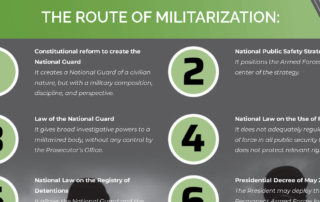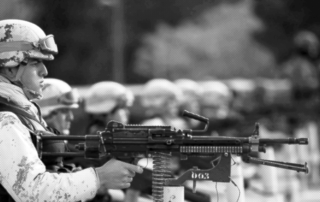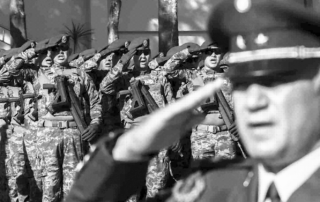Ilustration: Juan Pablo Gaviria
A deficient National Law on the Use of Force
The National Law on the Use of Force, published in the Official Federal Gazette on May 27, 2019, injects uncertainty to the exercise of the right to demonstrate and, specially, to protest, as well as to the protection of life and integrity. The SCJN resolved the unconstitutionality action filed by the previous CNDH leadership, leaving worrying elements in force.
From a human rights point of view, this law is of concern in three respects: it does not fully incorporate the internationally recognized principles on the use of force; it provides for a deficient regulation of the use of lethal force; and it does not observe what was ordered by the Inter-American Court of Human Rights in the ruling of the Atenco case.
By establishing that public force can be used to protect not only people’s rights but also abstract goods, incorporating a vague definition such as “public order or peace”, the law allows the will of the authorities to decide on the use of force, affecting other rights such as freedom of expression and assembly, in addition to life and integrity.
As if that were not enough, the law provides for an assumption in which “lethal force” can be required and authorized from the planning stages, breaking with the scheme of gradual use and without proving the need of force in the facts of the moment and contravening Mexico’s obligations regarding the protection of the right to life.
Additionally, Articles 27 and 28 allow peaceful demonstrations or meetings that are not carried out “with a lawful purpose” to be dealt with using weapons, leaving it to the discretion of the authority to determine said “lawful purpose.” The rest of the rule is also concerning, since it allows an entire demonstration to be classified as “violent” and lethal force be used against it.

Third, and considering that the rights and obligations of the Federal Police (PF) were passed on to the National Guard, the law omitted the creation of a mechanism for monitoring the use of force by the PF and the State of Mexico police, as ordered by the Inter-American Court of Human Rights in the case of Mujeres Víctimas de Tortura Sexual en Atenco vs. México.[1] The judgment also ordered the creation of an independent observatory on accountability and monitoring of the use of force by the PF and the State of Mexico police with the participation of civil society. The National Guard Law does not provide for the creation of any external control mechanism but only of an Internal Affairs Unit.
Unfortunately, when ruling on the unconstitutionality action filed by the previous CNDH leadership in November 2021, the SCJN missed an opportunity to reinforce controls and standards on the use of the public force.
Although in the discussion the SCJN did consider that the law inadequately and partially incorporates the principles that should regulate the use of force and ordered that this failure be corrected by the legislative branch, most of the ministers validated articles on the use of lethal force (Article 36) and the use of force in protest contexts (Articles 27 and 28), which are highly problematic from a human rights perspective.
This resolution raises concerns about the completeness and level of scrutiny with which the unconstitutionality action filed against the National Guard Law and the constitutional controversy filed against the March 2020 Presidential Decree will be analyzed. It is desirable that, in these matters, the legal analysis of the plenary of the SCJN be more comprehensive.













